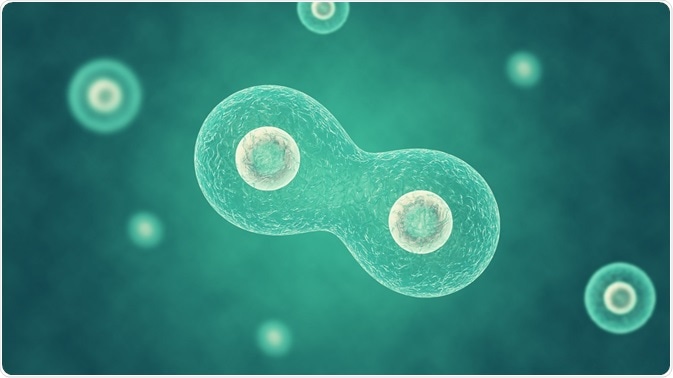The Mechanism of DNA Damage by UV Radiation
Solar ultraviolet radiation (UV) exposure triggers DNA damage, a preliminary step in the process of carcinogenesis.

Credit: janez volmajer/Shutterstock.com
The stability of DNA is extremely important for the proper functioning of all cellular processes. Exposure to UV radiation alters the structure of DNA, affecting the physiological processes of all living systems ranging from bacteria to humans.
Ultraviolet Radiation
Natural sunlight stimulates the production of vitamin D, an important nutrient for the formation of healthy bones. However, sunlight is also a major source of UV radiation. Individuals who get excessive UV exposure are at a great risk of developing skin cancers. There are three types of UV rays: UVA, UVB and UVC.
- UVC rays (100-280 nm) are the most energetic and damaging of the three rays. Fortunately, UVC is absorbed by the ozone layer before reaching the earth’s surface.
- UVA rays (315-400 nm) possess the lowest energy and is able to penetrate deep into the skin. Prolonged exposure has been linked to ageing and wrinkling of the skin. UVA is also the main cause of melanomas.
- UVB rays (280-315 nm) possess higher energy than UVA rays and affect the outer layer of the skin leading to sunburns and tans. Basal cell carcinoma and squamous cell carcinoma are caused by UVB radiation.
DNA Damage by UV Radiation
DNA is composed of two complementary strands that are wound into a double helix. The hereditary message is chemically coded and made up of the four nucleotides adenine (A), thymine (T), guanine (G) and cytosine (C).
UVB light interferes directly with the bonding between the nucleotides in the DNA. The two main DNA lesions formed by exposure to UVB are cyclobutane pyrimidine dimers (CPD) and 6-4 pyrimidine pyrimidone photoproducts (6-4PPs), and its Dewar isomers.
CPDs are formed when two adjacent pyrimidine bases (thymine –TT or cytosine – CC) become covalently linked producing a cyclic ring structure. 6-4PPs result from a single covalent bond formed between the 5’ end of C6 and 3’ end of C4 of adjacent pyrimidines. This leads to the formation of an unstable oxetane or azetidine intermediate depending on whether the 3’ end base is a thymine or cytosine.
Subsequent spontaneous rearrangement of these intermediates gives rise to 6-4PP. The pyrimidine dimers cause a kink in the DNA backbone, halting transcription and protein synthesis. 6-4 pyrimidine pyrimidone adducts undergo isomerization to their Dewar form upon exposure to another photon of light from UVB or UVA radiation. The most common mutation induced by UVB is C to T transversion. Double base substitutions (CC to TT) also occur, albeit less frequently.
UVA (and also UVB) radiation cause indirect damage to DNA via absorption of photons by non-DNA chromophores. This generates reactive oxygen species like singlet oxygen or hydrogen peroxide that oxidize the DNA bases causing mutations. The most common mutation is the G-T transversion wherein guanine gets oxidized into 8-oxo- 7,8-dihydroguanine (8-oxoG) hindering its pairing with cytosine. During the replication process, 8-oxoG pairs with adenine. When the second strand is synthesized, 8-oxoG is replaced with a thymine leading to a G-T transversion.
DNA Repair
The genetic lesions produced by UV radiation are often repaired soon after they are formed, through a process called nucleotide excision repair. A nuclease enzyme recognizes and removes a segment of DNA containing the lesion. Then, the polymerase inserts the correct bases and ligase seals the gap. However, if unrepaired lesions accumulate or the repair mechanism is faulty, it can lead to cell death, mutagenesis and even cancer.
Sources:
- Sinha RP, Häder DP “UV-induced DNA damage and repair: A review.” Photochem Photobiol Sci. 2002 Apr; 1(4):225-36. Review
- Rastogi RP, Richa, Kumar A, Tyagi MB and Sinha RP “Molecular mechanisms of ultraviolet radiation-induced DNA damage and repair.” J Nucleic Acids. 2010 Dec 16;2010:592980. doi: 10.4061/2010/592980
- Ravanat JL, Douki T and Cadet J “Direct and indirect effects of UV radiation on DNA and its components.” J Photochem Photobiol B. 2001 Oct;63(1-3):88-102. Review
Further Reading
- All DNA Content
- What is DNA?
- DNA Properties
- DNA Chemical Modifications
- DNA Biological Functions
Last Updated: Feb 26, 2019
.jpg)
Written by
Dr. Supriya Subramanian
Dr. Supriya's passion for scientific writing began with her Bachelor’s of Science (B.Sc.) degree in Medical Laboratory Technology at the Postgraduate Institute of Medical Education and Research (PGIMER), India. She went on to study a Ph.D. in protein biology and then spent two years as a post-doctoral researcher studying membrane transport. She has hands-on experience of fluorescent microscopy, siRNA knockdown and tissue biology. Now a freelance writer, Supriya approaches her articles with a focus on cell physiology, molecular biology, membrane biochemistry, and biophysics.
Source: Read Full Article



